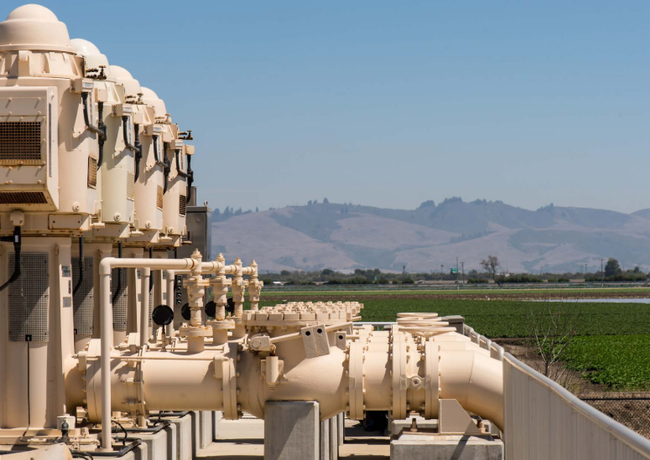Report: Wastewater recycling essential to resilient water future for LA region
Wastewater recycling in Los Angeles is the focus of a new report released by the UCLA Luskin Center for Innovation and the UC Agriculture and Natural Resources. The report, Making the Most of Landmark Recycled Water Investments in Los Angeles: Technical Advisory Recommendations for the Region, was commissioned by Los Angeles Waterkeeper. The goal of the report is to support ongoing efforts to improve local water security and rely less on expensive, energy-intensive and increasingly unreliable water imports from faraway places, like the Sacramento-San Joaquin Delta and the Colorado River.
Experts involved in developing the report agree that expanding the use of recycled wastewater has emerged as a key, scalable water supply strategy that can offer certainty and reliability in the region in light of our new climate reality.
“Both the Metropolitan Water District of Southern California and the City of LA's Department of Water and Power have made significant investments in wastewater recycling, and they plan to do more,” said Bruce Reznik, executive director of LA Waterkeeper. “But there are a lot of moving parts and some critical decisions to be made in the short term if we're going to make significant progress toward reliable local water supplies.”
“The purpose of this report is to help decisionmakers see the full picture so they can prioritize and develop informed strategies for expanding and integrating the disparate wastewater recycling projects into a more cohesive wastewater system – all while taking community voices and environmental impacts into account,” he added.
Local leaders recognize the region must further invest in equitable, climate-smart, affordable local water strategies. LA County's Water Plan, released in late 2023, calls for 80% of water to come from local sources by 2045 (compared with approximately 40% currently). Four major centralized wastewater recycling projects, including two that are landmark in size and scope, have either broken ground or are in the active planning stages throughout Los Angeles County. Collectively, this regional effort may represent the most important water supply investment in the American West in the last half century.
“In many ways, our region has taken great strides toward embracing wastewater recycling,” said report co-author Edith B. de Guzman, UC Cooperative Extension water equity and adaptation policy specialist. “But we need a clearer pathway for how these projects can be built and possibly integrated into a more cohesive system. This report provides a blueprint for water agencies on the project design, community engagement and governance steps that must be made to ensure progress toward rapidly increasing our local water independence.”
Upwards of $20 billion in investment in wastewater recycling projects is planned for the coming years. But as local water and wastewater agencies make these investments, it's essential that they design systems to both maximize benefits and minimize impacts that could be damaging to people and the environment, all while ensuring water remains affordable. Just as importantly, the report flagged the need to effectively engage the public in key decisions to foster public trust in these emerging water technologies and facilitate coordination between agencies to create a resilient regional water supply system.
Specific action items identified in the report are organized under eight principal recommendations:
- Take actionable steps on current key decision points pertaining to major recycling facilities. The report encourages agencies to make several decisions that will impact the design of the overall wastewater recycling systems imminently. These include resolving differences between the City of LA's Hyperion 2035 and Operation NEXT efforts, deciding whether to upgrade existing wastewater recycling infrastructure like the Edward C. Little Water Recycling Facility, and making key pipeline and routing decisions.
- Conduct a more nuanced regional analysis of system facilities, with an emphasis on evaluating distributed alternatives. While some assessment of a more distributed system has been undertaken, additional analysis is still needed on the issues of energy demand, the cost of distributing water under different alternatives, and impacts on aquatic and marine ecosystems.
- Identify and establish a structure for collaborative governance that enables agencies to work together to realize a regional advanced wastewater recycling network.
- Adopt a coordinated monitoring plan to ensure water quality is safeguarded for public and ecological health.
- Balance the adoption of Indirect Potable Reuse (IPR) and Direct Potable Reuse (DPR) with a near-term focus on IPR to the extent feasible and using DPR to fill in service gaps.
- Perform robust regional forecast and impact analyses to improve future-proofing of facility and network designs, maximize benefits, minimize harm, and avoid stranded assets.
- Design and execute a collaborative communication and community engagement strategy that offers a clear narrative, emphasizes the benefits of a secure water supply, meets the needs of water customers, and is delivered by trusted messengers.
- Coordinate across agencies on strategies to attract project financing while taking household affordability into account.
“This report is by no means the final word,” said co-author Gregory Pierce, research and co-executive director at UCLA Luskin Center for Innovation. “The point of this study is to provide guidance and spur discussion, and we hope and expect to see ongoing research and coordination on all of these issues.”
The report was informed by input from a Technical Advisory Committee of 20 people from fields including academia and think tanks, conservation advocacy, labor, the private sector, and current and former water district leaders not affiliated with the projects that are the focus of the report. This effort also benefited from the feedback and insight of more than 20 public agency representatives, including many from the City of Los Angeles (including Los Angeles Department of Water and Power and LA Sanitation and Environment), Metropolitan Water District of Southern California, Los Angeles County Sanitation Districts, Las Virgenes Municipal Water District, and West Basin Municipal Water District.
The full report is available at https://innovation.luskin.ucla.edu/wp-content/uploads/2024/06/Making-the-Most-of-Landmark-Recycled-Water-Investments-in-LA.pdf.



Posted by Dennis Evans on July 27, 2024 at 8:47 AM